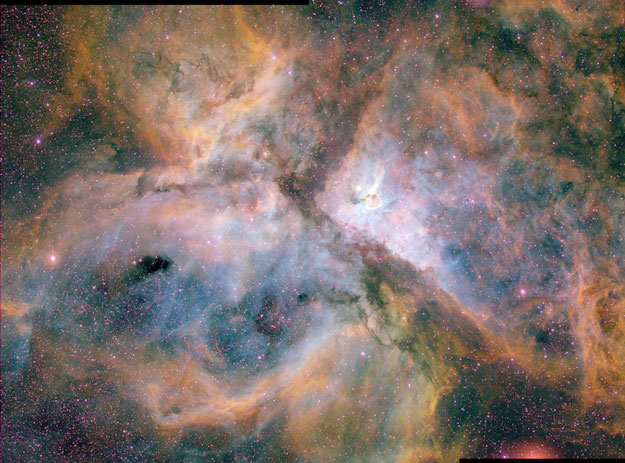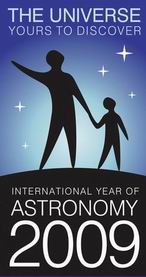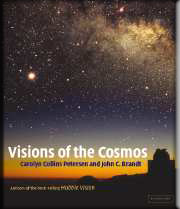 |
 The SpaceWriter's Ramblings |
 |
||
|
|
|
|
||
|
Anything and everything about science, especially astronomy and the cosmos. NOTE: This blog has migrated to a new address. Please update your favorites link accordingly.Visit my web site at Posting times are Powered by
|
4.28.2004 Cosmic Galaxy Ballet
Courtesy the Very Large Telescope (includes larger versions of this image).As astronomers gaze across the deeps of space and time, they run across scenes like this one — where two (or more) galaxies just get too close to each other for comfort. When this happens, sometimes galaxies end up colliding.
The European Southern Observatory's Very Large Telescope caught a glimpse of a cosmic tango taking place 190 million light-years away in the direction of the southern hemisphere constellation Pavo, the Peacock. And, like Hubble's spectacular image of a ring galaxy (created by yet another collision), this VLT image was taken to celebrate another telescopic anniversary — the VLT's fifth birthday.
So what's happening in this scene?
NGC 6769 (the one on the upper right) is a spiral galaxy with very tightly wound spiral arms. Its neighbor (NGC 6770) has two major spiral arms. One looks rather straight and points towards the outer disc of NGC 6769. NGC 6770 is also peculiar because it shows two comparatively straight dark lanes and a fainter arc that curves towards the third galaxy toward the bottom of the image, called NGC 6771 (below). Stars and gas have been stripped off of both NGC 6769 and NGC 6770, and they're starting to form a common envelope around them. Some folks have suggested it looks like the shape of a Devil's Mask. There might also be a tenuous bridge between NGC 6769 and NGC 6771. All of these features are there because there's strong gravitational interaction between the three galaxies.
Well, you might think that such a collision would destroy the galaxies and any chances for the normal things that galaxies do (like host star-forming regions). Not... quite...
There is a true baby-star boom going on in this scene. A cosmic catastrophe like this one normally results in the formation of many new stars, which you can see in the blueish clouds that highlight the spiral arms in NGC 6769 and NGC 6770. There are many sites of star-forming regions.
VLT, and other telescopes (including HST) are studying a great many cosmic collisions like this one to help scientists figure out how and why galaxies form, evolve, and change over time. There'll no doubt be more cool pix like this one in the years to come!
4.27.2004 Wanna See A Comet or Two?If you've always wanted to spot a comet with your very own eyes, there are a couple of them inbound that you should be able to see in the next few weeks. They're called Comet LINEAR and Comet NEAT. Right
For now, in the final week of April and the first few days of May, North American and European skywatchers do have a shot at spotting Comet LINEAR before dawn on clear mornings. Look with binoculars just above the horizon due east about 60 minutes before your local time of sunrise.
Later on in the month, both LINEAR and NEAT will come into in the evening sky. Starting around May 5th or 6th, scan for Comet NEAT just above the southwest horizon as evening twilight fades. Look for a small, fuzzy "star" with a small tail pointing to the upper left. (The much brighter star Sirius will also be low in the southwest; on May 5th the comet will be not far to its left, and on May 6th the comet will be to Sirius's upper left.) In the next two weeks Comet NEAT will get much higher in the southwest at nightfall, though it will also fade. Binocular users may be able to follow it through the end of May.
Thanks to Alan MacRobert at Sky & Telescope for this information!posted by CCP on 4/27/2004 12:47:00 PM | * 4.26.2004 Sedna: The Latest of the Outermost PlanetoidsYou gotta love the Hubble Space Telescope. There it is up there, looking out across the deeps of space and time, spotting shreds of galaxies as they formed some 300,000 to 500,000 years after the Big Bang, and then it turns around and gives us a view of a little shard of a world called Sedna. This place, smaller than the Moon, smaller than Pluto, lies about 90 times the distance between the Earth and Sun, out in a region of the solar system called the Kuiper Belt. It's a leftover bit of ice (mostly) from the formation of the solar system some 5.5 billion years ago. It's so dim and small that HST's image is one pixel across. But, it's an informative pixel!

For instance, it tells us that (so far) HST hasn't spotted a companion to this planetoid, although the astronomer who discovered it on March 15, 2004, calculated its spin rate (it's "day") and determined that it should have a moon of some kind. The fact that it doesn't illustrates one of those wonderful "non-results" that tells us valuable information. Science is replete with stuff like this — what looks like a non-result actually helps us put limits on an object's actions or size or mass or other characteristic. It reminds me of the observation run I did in Hawaii where we studied Comet Hale-Bopp in late 1996. We thought we might be able to spot a plasma tail forming earlier than might be expected. However, when we examined the data, we found no evidence of the plasma tail, which told us that even with a comet of that size, it had to be close enough to the Sun (essentially within about 2 to 2.5 AU of the Sun) before its plasma tail would form. It helped us nail down parts of a descriptive theory we were formulating about how and when and why these glowing tails form when they do as a comet approaches the Sun during its orbit.
Astronomers will keep studying Sedna, and in fact, they have looked at it with other telescopes since its discovery. Expect to see a few more announcements about this frigid world at the frontiers of the solar system!
4.23.2004 Fourteen Years of Great Science
A ring of brilliant blue star clusters wraps around the yellowish nucleus of what was once a normal spiral galaxy in this new image from NASA's Hubble Space Telescope (HST). The galaxy, catalogued as AM 0644-741, lies 300 million light-years away in the direction of the southern constellation Dorado. A larger view is available here.On April 24th NASA and Hubble enthusiasts everywhere will celebrate the 14th anniversary of the launch of what has become one of the best-known orbiting telescopes of our time. The Space Telescope Science Institute released the picture above to commemorate the occasion. Of course there were times when it didn't seem like the scope would ever do anything as lovely as this image, but the scientists and technicians have more than overcome the problems and we see these kinds of sights routinely.
For me this anniversary is also another milestone. This week Mark and I are releasing our latest Hubble planetarium show, and although the release wasn't really timed to take advantage of the anniversary, I guess it's pretty apropos. I've talked in these pages before about how the HST has been part of my life since that fateful day — I've written a master's thesis, three shows (one of them also a video), two books, and bunches of articles on the telescope, its science, and public perceptions of the project. It's a fascinating topic, combining not just the purity of lovely images and data, but also the very human traits of curiosity, intelligence, and of course, hubris.
If you've never browsed through the tremendous archive of images over at Hubblesite.org, go take a visit and see what HST has accomplished over 14 years, encompassing observations of thousands and thousands of objects by teams of thousands and thousands of scientists. Celebrate HST!
4.19.2004 Serendipitous StargazingWe've had an unexpected (but welcome) warm spell here in the Northeast U.S. today. That means later on I can go out and do a little warm-night skygazing at the spring stars overhead. It's not often we can do that in April around here. And, actually, there's a good chance that it'll cloud up and rain sometime soon, so I don't want to lose the opportunity! In this stargazing business, you have to grab your chances when you can!
A few years ago I remember going out in downtown Boston (I lived in the North End for a short time) and being amazed to find Comet Hale-Bopp! It was bright enough we could see it from the middle of all the city lights. In fact, Mark and I grabbed the wait staff at the restaurant where we'd just had dinner and showed them the comet. Of course, it wasn't all that warm (being late March at the time), but the generous impulse was appreciated. People respond to nifty cool things like being able to see a comet from a spot where, by all rights, they shouldn't have a chance. A friend of mine who lives in New York City has regaled me with tales of taking her little scope out to a park near her place and showing people Mars and Saturn and Jupiter and the Moon. So, you never know when you might get a chance to see a celestial sight — and maybe share it with somebody!
4.13.2004 Ship's Keel
Carina Nebula, courtesy of Astronomy Picture of the DayIn 2001 we went on a cruise around South America and I was the ship's astronomy lecturer. My job was to help the paying passengers do some stargazing and give them some fun lectures about the stars. It was great fun, and I had a marvelous time getting to know the Southern Hemisphere skies along with my shipmates. One of our favorite areas to look was the constellation Carina, which harbors the great luminous blue variable Eta Carinae. This (probable) double star system is on the verge of tearing itself apart, and when it does the view should be spectacular.
The Nebula itself is made up of cast-off material from the star system, and there is evidence of star-forming activity inside the clouds. So, the whole area is being watched with great interest by those who want to understand the mechanics of starbirth and stardeath.
Of course we couldn't see any of this from the ship — our view was "limited" to the gaspingly beautiful southern Milky Way and the Magellanic Clouds and all the other sights we don't get much chance to see from the Northern Hemisphere. The sky is just full of great stuff to study, and if you travel a lot, it enhances your visits to other lands.
4.11.2004 Headin' For The Hills Courtesy of the Mars Exploration Rover Page.
|

Earth Hour! Do it for the Planet!
Blog RollPlanetarium-relatedLoch Ness ProductionsPurveyors of fine planetarium shows, music, and services. INTENSELY Good Space Music from a master in the genre! My cool astronomy cause: ScienceThe sites below belong to space and astronomy enthusiasts. I make every effort to check them and make sure they are still appropriate. However, I am not responsible for their content, nor do I endorse any of it by simply linking to them. As with all Web surfing, please exercise caution. Adot's Notblog A fellow traveler blogger and astronomy enthusiast! Astronomy Blog An astronomy blog pondering the big questions Astronomy Cast Astronomy Podcasting from Pamela Gay BadAstronomy.com Bad astronomy discussed and debunked along with fun stuff about really good astronomy! Chris Lintott's Universe Musings from an Oxford Astronomer. Cosmic Variance Random Samplings from a Universe of Ideas. Dave P's Astronomy blog Observational Astronomy and other TidBits European Southern Observatory Fine Ground-based astronomy images. Gemini Observatory Fine astronomy in infrared and visible wavelengths. Griffith Observatory's page. I wrote their exhibits! Observing The Sky Nightly Observation Reports from dedicated skygazers. The Official String Theory Web Site. Time to feed your mind! Pharyngula Evolution, development, and random biological ejaculations from a godless liberal. Cast off your blinders and come on in! Science Made Cool A compendium of discoveries, inventions and commentary. Slacker Astronomy Astronomy with a Slacker Twist. Space Telescope Science Institute The best from Hubble Space Telescope The Eternal Golden Braid Astronomy, Space Science, and Science Fiction Commentary. The Inoculated Mind Bills Itself as a weekly science mindcast. Thought-provoking, honest. Truth. UniqueThe Hairy Museum of Natural History
|





